There is still a lot we don’t know about our ancestors’ behavior and diet – but it may have been somewhat slimier than you might expect. According to a recent study, African land snails may have been an integral part of human diets. Using spectroscopy, the researchers uncovered evidence that vast numbers of snails were brought to Border Cave in South Africa between 170,000 and 70,000 years ago to be cooked and eaten. In addition to being in the running for The Analytical Scientist team’s most unusual application of analytical science award, the study does have some important social implications: the transport of snails to a home base suggests food sharing among early Homo sapiens. To gain more insight, we spoke to the lead author of the study, Marine Wojcieszak, Research Fellow at the Royal Institute for Cultural Heritage in Brussels, Belgium.
What were the key findings of your research?
The dominant view before undertaking this study was that the consumption of small game (birds, fish, reptiles, and land snails) increased greatly at the end of the Ice Age as a consequence of the disappearance of large herds of herbivores. Our research shows that this so-called “small spectrum revolution” is probably a simplistic and Eurocentric view as the consumption of certain species preceded this late adaptation.
We also discovered that food was shared amongst groups – a sign that cooperative social behavior was in place from the dawn of our species. Hunters and gatherers provided an important food source for those unable to forage themselves, such as young children and the elderly. The easy-to-eat fatty protein of snails would have been crucial for these individuals. It is interesting to see that altruism was just as fundamental in the early days for survival and well-being as it is today.
What analytical techniques did you apply to your research?
We used infrared and Raman spectroscopies, as well as scanning electron microscopy (SEM). These non-invasive, non-destructive techniques were preferred to preserve the integrity of the artifacts. Raman and Fourier transform infrared (FTIR) spectroscopies were used to follow the molecular/crystallographic transformation from aragonite to calcite. We used SEM as a key method in the study to view the shell surfaces at a microscopic scale, showing modifications related to rapid drying from heat.
What challenges did you encounter?
Our main challenge was the fluorescence signal obscuring the Raman readings. This often occurs when analyzing archeological samples that have been buried for some time and contain organic matter – in particular humic acids – which are responsible for the fluorescence. When the samples couldn’t be analyzed in depth using Raman spectroscopy, we used FTIR spectroscopy.
We also had issues in defining temperatures and times of heating in the experimental part of the study. Tough choices have to be made when trying to replicate what happened in archeological sites. In heating the shells, we hoped to define temperature ranges for chemical and color transformations. Unfortunately, some pieces shattered in the furnace and were extremely difficult to recover. Due to this, some of the data is missing in our weight loss table. The brittleness of the shells caused many challenges, but we pushed through to the end.
Which analytical techniques are most useful in archaeological studies?
It depends on the questions asked by archeologists. Some methods are complementary, while others work at different scales – interdisciplinary methods are often key for answering important questions. I find that non-invasive methods are best – and keeping abreast of the literature is the best way to know what type of analysis to apply to a situation. I also find it useful to contact specialists in the field regarding the specific application of techniques to see if it’s wise to embark on a time-consuming and costly mission. Undertaking pilot studies to confirm the importance of a specific application is always worthwhile.
Are there any plans to continue with this research?
Excavations continue to go ahead at Border Cave, so we may yet make further discoveries…

References
- M Wojcieszak et al., Quaternary Science Reviews (2023). DOI: 10.1016/j.quascirev.2023.108030.




